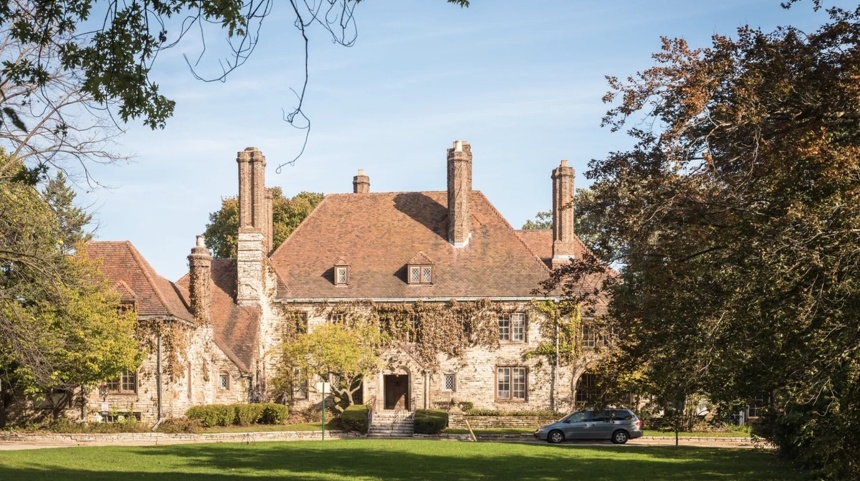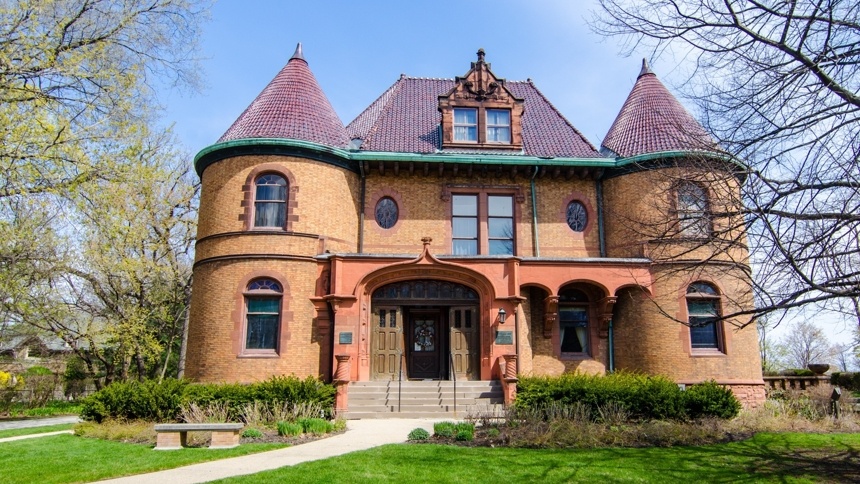Evanston, Illinois, is home to a rich architectural history that tells the story of its growth and development over the years. From stately mansions to historic landmarks, the city is filled with architectural gems that showcase various styles and time periods. In this comprehensive guide, we’ll take you on a tour of some of Evanston’s most notable historic homes and landmarks, so let’s embark on this architectural journey!
1. Charles Gates Dawes House
Built in 1894, the Charles Gates Dawes House is a stunning example of the Châteauesque style and is listed on the National Register of Historic Places. Once home to Charles Gates Dawes, the 30th Vice President of the United States, this elegant mansion now houses the Evanston History Center. The beautifully preserved interiors, complete with period furnishings, provide a glimpse into Evanston’s past and the Dawes family’s life.
An important landmark in Evanston, but its architectural significance also merits further exploration. Built in 1894, this elegant Chateauesque-style mansion was designed by architect Henry Edwards Ficken. The house features a variety of decorative elements, such as turrets, gables, and intricate stone carvings, which make it a standout example of its architectural style.
2. Frances Willard House Museum
The Frances Willard House Museum is another important historical residence in Evanston. Constructed in 1865, this Gothic Revival style home was the residence of Frances Willard, a prominent suffragist and social reformer. The house now serves as a museum, offering guided tours and exhibits that illuminate Willard’s life and her work in the temperance movement and women’s suffrage.
3. Grosse Point Lighthouse
As a vital navigational aid on Lake Michigan, the Grosse Point Lighthouse was built in 1873 and is now a National Historic Landmark. The lighthouse, designed in the Italianate style, stands 113 feet tall and offers incredible views of the lake and surrounding area. Tours of the lighthouse and its grounds provide a fascinating look into the history of maritime navigation and life at the turn of the century.
4. Harley Clarke Mansion
The Harley Clarke Mansion, an impressive Tudor Revival style building, was constructed in 1927 for Harley Lyman Clarke, a wealthy utility executive. The mansion, situated along the lakefront, is surrounded by lush gardens and offers stunning views of Lake Michigan. While the future of the mansion remains uncertain, its architectural beauty and historic significance make it a must-see stop on any Evanston tour.
5. The American Four-Square Houses
Evanston boasts numerous examples of American Four-Square houses, a popular architectural style in the early 20th century. These homes are characterized by their boxy, two-and-a-half-story design, hipped roofs, and large front porches. The simplicity and functionality of this style make it an enduring favorite, and you’ll find many well-preserved examples throughout Evanston’s historic neighborhoods.
6. The Emil Bach House

Designed by the world-renowned architect Frank Lloyd Wright, the Emil Bach House is an exquisite example of the Prairie School style. Completed in 1915, this home showcases Wright’s signature design elements, such as horizontal lines, flat roofs, and an emphasis on integrating the structure with its natural surroundings. The home is now available for tours and private events, providing a unique opportunity to experience Wright’s genius firsthand.
7. The Lake Street Church
Built in 1875, the Lake Street Church is a striking example of Gothic Revival architecture. The church’s magnificent stained-glass windows, soaring steeple, and intricate woodwork make it a beloved landmark in the Evanston community. Guided tours offer insights into the history of the congregation and the significance of the church’s architectural features.
8. The Woman’s Club of Evanston
The Woman’s Club of Evanston, an elegant Georgian Revival style building, was completed in 1913 to serve as a gathering place for the club’s members. The organization, founded in 1889, has played a significant role in Evanston’s history, championing social, educational, and philanthropic causes. The building’s grand facade, stately columns, and well-maintained interiors make it an architectural gem and an important piece of the city’s history.
9. The Merrick Rose Garden
Established in the 1930s, the Merrick Rose Garden is a beautiful green space in Evanston, showcasing a stunning array of roses and other flowers. The garden’s centerpiece is a charming gazebo designed in the Victorian style, offering a picturesque setting for relaxation and reflection. The Merrick Rose Garden is not only an example of landscape architecture but also a testament to the community’s commitment to preserving its natural beauty and history.
10. The Fountain Square Building
The Fountain Square Building, built in 1928, is a prime example of Beaux-Arts architecture in downtown Evanston. The structure’s ornate facade, adorned with decorative details and elegant statuary, makes it an eye-catching landmark in the city. Today, the building houses a variety of businesses and continues to serve as a testament to Evanston’s rich architectural history.
11. The George H. Swift House
Constructed in 1908, the George H. Swift House is another beautiful Frank Lloyd Wright-designed residence in Evanston. This Prairie School style home features many of Wright’s signature design elements, such as the emphasis on horizontal lines and the integration of the building with its environment. The house remains a private residence, but its exterior can be admired from the street.
12. The Nicholas J. and Nellie O. Murphy House
Built in 1896, the Nicholas J. and Nellie O. Murphy House is a splendid example of Queen Anne style architecture. This historic home features a distinctive turret, intricate woodwork, and a lovely wraparound porch. Although it remains a private residence, the house’s exterior is a visual treat for architecture enthusiasts.
13. The Oscar Mayer House
The Oscar Mayer House, built in 1901, was once home to the famous meat-packing mogul, Oscar F. Mayer. This elegant Colonial Revival style residence showcases a grand facade, impressive columns, and a stately entrance. While it is still a private home, its exterior beauty and historical significance make it a noteworthy stop on any architectural tour of Evanston.
14. The Old Orrington School
The Old Orrington School, constructed in 1893, is a beautiful example of the Richardsonian Romanesque architectural style. With its distinctive round arches and rough-hewn stone, the building has been repurposed as condominiums but retains its historical charm. It serves as a reminder of Evanston’s commitment to preserving its architectural heritage.
Evanston’s rich architectural history is evident in its beautifully preserved historic homes and landmarks. From grand mansions to charming public spaces, the city’s diverse styles and periods showcase the creativity and craftsmanship of the architects who contributed to its growth. As you explore Evanston, take the time to appreciate these architectural gems and the stories they tell about the city’s past and present.
15. The Harley Clarke Mansion

The Harley Clarke Mansion, built in 1927, is a historic Evanston landmark and a fine example of the English Tudor Revival style. Designed by architect Richard Powers, the mansion features half-timbered walls, steep gables, and leaded glass windows. Overlooking Lake Michigan, the mansion was once a private residence and later served as the Evanston Art Center. Although its future is uncertain, the Harley Clarke Mansion remains an important part of the city’s architectural heritage.
16. The Joseph E. Hill Education Center
Originally constructed in 1907 as Evanston Township High School, the Joseph E. Hill Education Center is an example of the Classical Revival architectural style. The building, designed by architects Arthur G. Moratz and Clarence Hatzfeld, boasts a symmetrical facade with a central entrance, intricate ornamentation, and decorative pilasters. Today, the center houses the administrative offices for Evanston/Skokie School District 65 and stands as a testament to the city’s ongoing commitment to education.
17. The First United Methodist Church
The First United Methodist Church, founded in 1854, is one of Evanston’s oldest congregations. The present church building, completed in 1910, showcases a striking Gothic Revival architectural style. With its pointed arches, ribbed vaults, and flying buttresses, the church stands as a beautiful and enduring place of worship in the heart of Evanston.
18. The Woman’s Club of Evanston
Another notable building in Evanston is the Woman’s Club of Evanston, designed by architect Ernest A. Mayo and completed in 1913. This Classical Revival building features a symmetrical facade, Ionic columns, and a pediment with a decorative frieze. The club’s long-standing commitment to community service and philanthropy is reflected in the stately architecture of its home.
19. The Northwestern University Technological Institute
The Technological Institute at Northwestern University, completed in 1942, is an example of the Stripped Classical architectural style. Designed by architect James Gamble Rogers, the massive structure features simplified classical elements, such as pilasters, columns, and a central entrance. The building houses the university’s engineering and applied sciences programs and stands as a symbol of the institution’s dedication to innovation and research.
Evanston’s diverse architectural styles and well-preserved historic buildings offer a unique window into the city’s past. There are many interesting things to do and see in Evanston. However, whether you’re an architecture enthusiast, a history buff, or just curious about the stories behind these beautiful structures, a tour of Evanston’s architectural gems is a rewarding and enlightening experience. As you walk through the city, take a moment to appreciate the craftsmanship, creativity, and history that have shaped this vibrant community.
 Schedule Appointment
Schedule Appointment 
